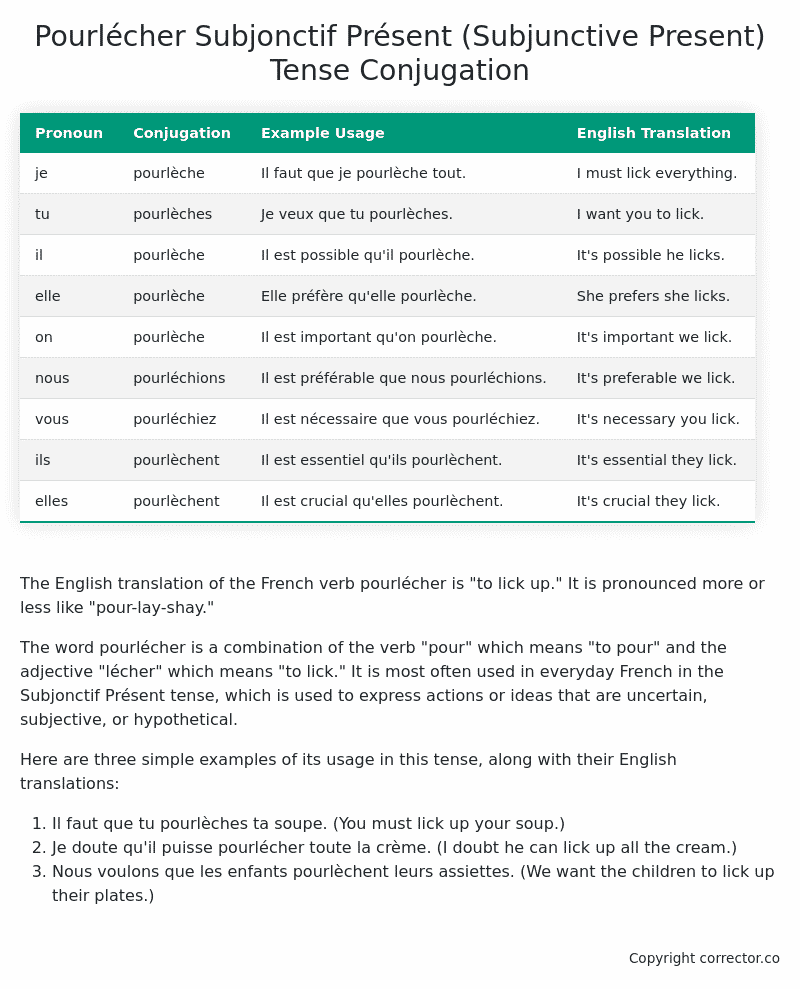Subjonctif Présent (Subjunctive Present) Tense Conjugation of the French Verb pourlécher
Introduction to the verb pourlécher
The English translation of the French verb pourlécher is “to lick up.” It is pronounced more or less like “pour-lay-shay.”
The word pourlécher is a combination of the verb “pour” which means “to pour” and the adjective “lécher” which means “to lick.” It is most often used in everyday French in the Subjonctif Présent tense, which is used to express actions or ideas that are uncertain, subjective, or hypothetical.
Here are three simple examples of its usage in this tense, along with their English translations:
- Il faut que tu pourlèches ta soupe. (You must lick up your soup.)
- Je doute qu’il puisse pourlécher toute la crème. (I doubt he can lick up all the cream.)
- Nous voulons que les enfants pourlèchent leurs assiettes. (We want the children to lick up their plates.)
Table of the Subjonctif Présent (Subjunctive Present) Tense Conjugation of pourlécher
| Pronoun | Conjugation | Example Usage | English Translation |
|---|---|---|---|
| je | pourlèche | Il faut que je pourlèche tout. | I must lick everything. |
| tu | pourlèches | Je veux que tu pourlèches. | I want you to lick. |
| il | pourlèche | Il est possible qu’il pourlèche. | It’s possible he licks. |
| elle | pourlèche | Elle préfère qu’elle pourlèche. | She prefers she licks. |
| on | pourlèche | Il est important qu’on pourlèche. | It’s important we lick. |
| nous | pourléchions | Il est préférable que nous pourléchions. | It’s preferable we lick. |
| vous | pourléchiez | Il est nécessaire que vous pourléchiez. | It’s necessary you lick. |
| ils | pourlèchent | Il est essentiel qu’ils pourlèchent. | It’s essential they lick. |
| elles | pourlèchent | Il est crucial qu’elles pourlèchent. | It’s crucial they lick. |
Other Conjugations for Pourlécher.
Le Present (Present Tense) Conjugation of the French Verb pourlécher
Imparfait (Imperfect) Tense Conjugation of the French Verb pourlécher
Passé Simple (Simple Past) Tense Conjugation of the French Verb pourlécher
Passé Composé (Present Perfect) Tense Conjugation of the French Verb pourlécher
Futur Simple (Simple Future) Tense Conjugation of the French Verb pourlécher
Futur Proche (Near Future) Tense Conjugation of the French Verb pourlécher
Plus-que-parfait (Pluperfect) Tense Conjugation of the French Verb pourlécher
Passé Antérieur (Past Anterior) Tense Conjugation of the French Verb pourlécher
Futur Antérieur (Future Anterior) Tense Conjugation of the French Verb pourlécher
Subjonctif Présent (Subjunctive Present) Tense Conjugation of the French Verb pourlécher (this article)
Subjonctif Passé (Subjunctive Past) Tense Conjugation of the French Verb pourlécher
Subjonctif Imparfait (Subjunctive Imperfect) Tense Conjugation of the French Verb pourlécher
Subjonctif Plus-que-parfait (Subjunctive Pluperfect) Tense Conjugation of the French Verb pourlécher
Conditionnel Présent (Conditional Present) Tense Conjugation of the French Verb pourlécher
Conditionnel Passé (Conditional Past) Tense Conjugation of the French Verb pourlécher
L’impératif Présent (Imperative Present) Tense Conjugation of the French Verb pourlécher
L’infinitif Présent (Infinitive Present) Tense Conjugation of the French Verb pourlécher
Struggling with French verbs or the language in general? Why not use our free French Grammar Checker – no registration required!
Get a FREE Download Study Sheet of this Conjugation 🔥
Simply right click the image below, click “save image” and get your free reference for the pourlécher Subjonctif Présent tense conjugation!

Pourlécher – About the French Subjonctif Présent (Subjunctive Present) Tense
Formation of the Subjonctif Présent
Common Everyday Usage Patterns
Interactions with Other Tenses
Summary
I hope you enjoyed this article on the verb pourlécher. Still in a learning mood? Check out another TOTALLY random French verb conjugation!


